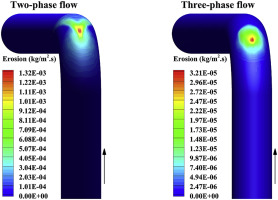Our official English website, www.x-mol.net, welcomes your
feedback! (Note: you will need to create a separate account there.)
3D computational modeling of sand erosion in gas-liquid-particle multiphase annular flows in bends
Wear ( IF 5.3 ) Pub Date : 2020-06-01 , DOI: 10.1016/j.wear.2020.203241 A. Farokhipour , Z. Mansoori , M. Saffar-Avval , G. Ahmadi
Wear ( IF 5.3 ) Pub Date : 2020-06-01 , DOI: 10.1016/j.wear.2020.203241 A. Farokhipour , Z. Mansoori , M. Saffar-Avval , G. Ahmadi

|
Abstract In the oil and gas industry, predicting sand particle erosion damage is a challenging task as many factors have profound effects on the material losses. In this study, a computational modeling approach was used, and the sand erosion in gas-liquid-solid annular three-phase flows in pipe bends was analyzed. The Volume of Fluid (VOF) and the hybrid Eulerian-Eulerian methods were used to simulate the 3D transient annular air-water flows, and the results were verified with comparisons with the available experimental data. The performed erosion simulation validation also indicated that the DNV erosion model predicts realistic results. The three-phase computational model (VOF and Lagrangian Particle Tracking) was used, and the effects of liquid film thickness, gas and liquid velocities, pipe orientation, sand mass flow rate, liquid viscosity, and bend angle on erosion in a standard elbow were investigated. The results showed that the liquid film cushioning effect in gas-liquid-solid flows significantly reduces the bend erosion compared with the gas-solid flows. Moreover, the gas velocity does not noticeably affect the liquid film thickness in the bend; however, a higher gas velocity causes a higher particle impact velocity and increases erosion. In contrast, higher liquid velocity enhances the film cushioning effect and leads to less erosion.
中文翻译:

弯道中气-液-颗粒多相环流中砂粒侵蚀的 3D 计算建模
摘要 在石油和天然气行业,预测砂粒侵蚀损害是一项具有挑战性的任务,因为许多因素对材料损失有深远的影响。本研究采用计算建模方法,分析了弯管内气-液-固环状三相流中的砂蚀。流体体积 (VOF) 和混合欧拉-欧拉方法用于模拟 3D 瞬态环形空气 - 水流,并通过与可用实验数据的比较来验证结果。执行的侵蚀模拟验证还表明 DNV 侵蚀模型预测了实际结果。采用三相计算模型(VOF和拉格朗日粒子追踪),液膜厚度、气液速度、管道方向、砂质量流量、液体粘度、研究了标准弯头腐蚀时的弯曲角度。结果表明,与气固流相比,气液固流中的液膜缓冲作用显着降低了弯曲冲蚀。此外,气体速度不会显着影响弯管中的液膜厚度;然而,较高的气体速度会导致较高的粒子冲击速度并增加侵蚀。相比之下,较高的液体速度会增强薄膜缓冲效果并减少侵蚀。较高的气体速度会导致较高的粒子撞击速度并增加侵蚀。相比之下,较高的液体速度会增强薄膜缓冲效果并减少侵蚀。较高的气体速度会导致较高的粒子撞击速度并增加侵蚀。相比之下,较高的液体速度会增强薄膜缓冲效果并减少侵蚀。
更新日期:2020-06-01
中文翻译:

弯道中气-液-颗粒多相环流中砂粒侵蚀的 3D 计算建模
摘要 在石油和天然气行业,预测砂粒侵蚀损害是一项具有挑战性的任务,因为许多因素对材料损失有深远的影响。本研究采用计算建模方法,分析了弯管内气-液-固环状三相流中的砂蚀。流体体积 (VOF) 和混合欧拉-欧拉方法用于模拟 3D 瞬态环形空气 - 水流,并通过与可用实验数据的比较来验证结果。执行的侵蚀模拟验证还表明 DNV 侵蚀模型预测了实际结果。采用三相计算模型(VOF和拉格朗日粒子追踪),液膜厚度、气液速度、管道方向、砂质量流量、液体粘度、研究了标准弯头腐蚀时的弯曲角度。结果表明,与气固流相比,气液固流中的液膜缓冲作用显着降低了弯曲冲蚀。此外,气体速度不会显着影响弯管中的液膜厚度;然而,较高的气体速度会导致较高的粒子冲击速度并增加侵蚀。相比之下,较高的液体速度会增强薄膜缓冲效果并减少侵蚀。较高的气体速度会导致较高的粒子撞击速度并增加侵蚀。相比之下,较高的液体速度会增强薄膜缓冲效果并减少侵蚀。较高的气体速度会导致较高的粒子撞击速度并增加侵蚀。相比之下,较高的液体速度会增强薄膜缓冲效果并减少侵蚀。











































 京公网安备 11010802027423号
京公网安备 11010802027423号